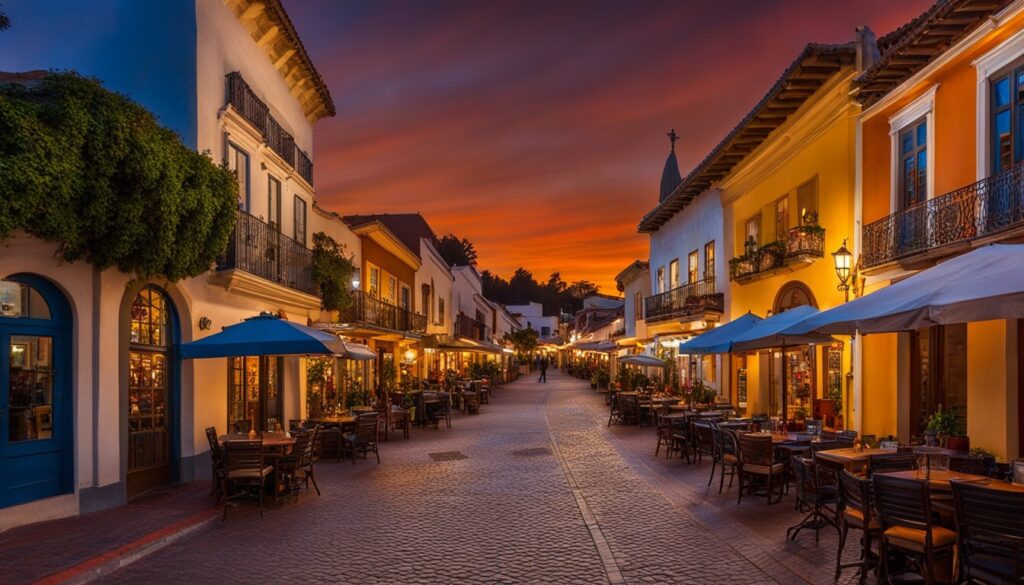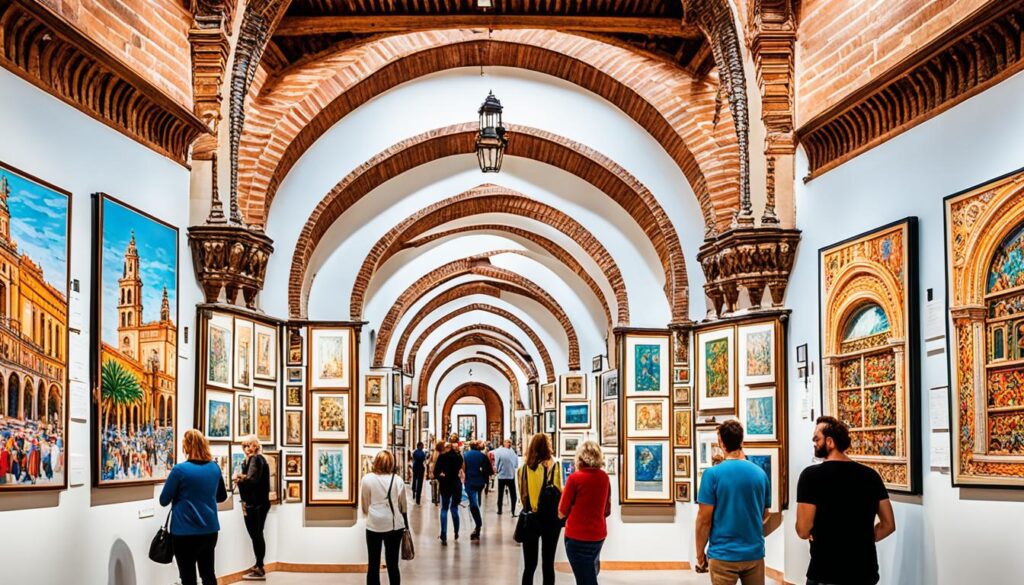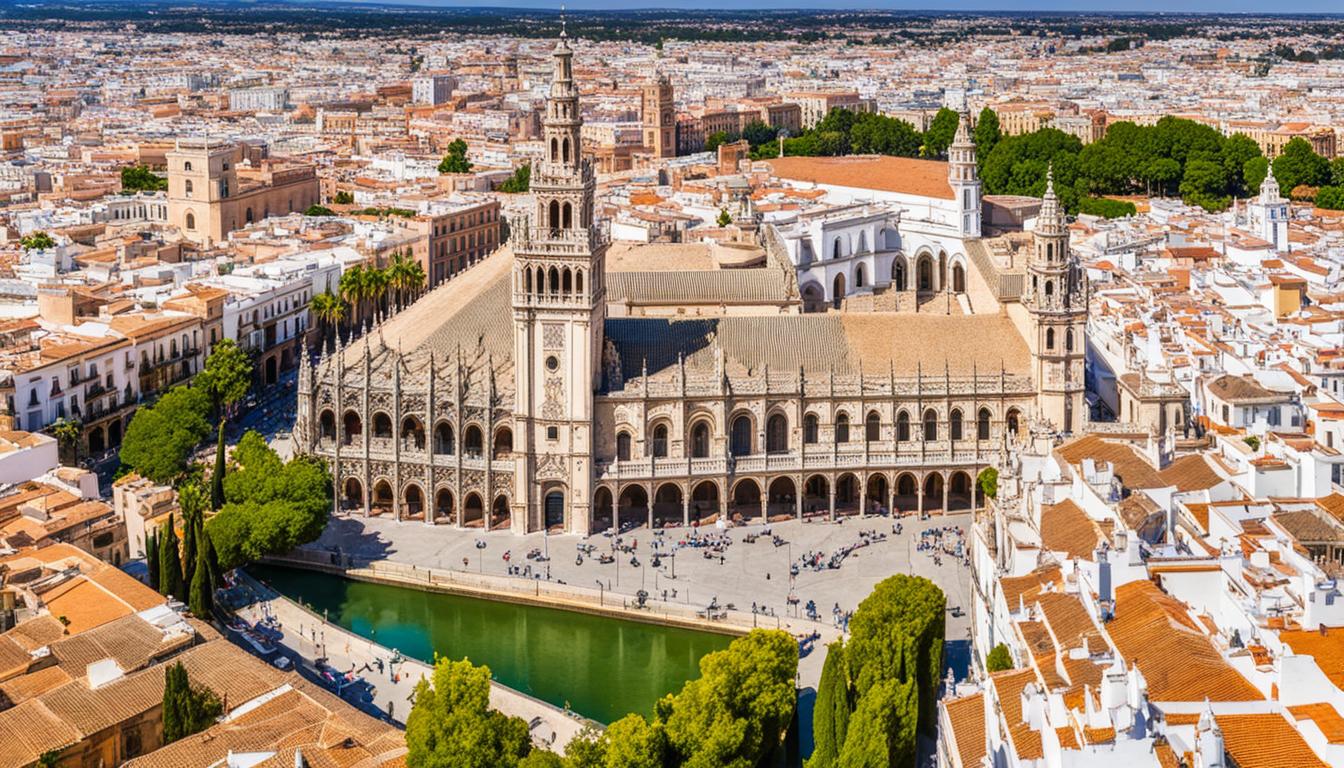Seville sits in southern Spain, right by the Guadalquivir River. It’s one of Spain’s oldest cities, filled with history since before the Romans. This city is a mix of cultures, from the Tartessos to the Romans, Visigoths, Muslims, and Christian kingdoms.
Seville is famous for its stunning architecture, landmarks, flamenco, and lively tapas. The city’s history is alive in its charming areas, historic churches, and palaces. There’s a lot to see, like the Royal Alcázar, the huge Seville Cathedral, the famous Plaza de España, and more.
Key Takeaways
- Seville is one of the oldest cities in Spain, with a rich history spanning various cultures and eras.
- The city is renowned for its stunning architecture, including the Royal Alcázar and the Seville Cathedral.
- Visitors can explore a wealth of historic landmarks, such as the Plaza de España and the Santa Cruz neighborhood.
- Seville’s vibrant tapas scene and iconic flamenco culture add to the city’s allure.
- The city’s location on the Guadalquivir River offers opportunities for riverboat cruises and exploring the region’s natural beauty.
Seville’s Architectural Wonders
The Royal Alcázar
The Royal Alcázar of Seville is a top spot for visitors. It’s a Moorish palace complex built on a Muslim fortress for King Peter of Castile. You’ll see a mix of Christian influence and Muslim features everywhere, like bright tile work and beautiful gardens.
These gardens are filled with peacocks, fountains, and exotic trees. Walking through, you can enjoy the beauty around you. From the top, you get amazing panoramic views of the city.
| Architectural Styles | Notable Features |
|---|---|
| Mudejar | Ornate geometric patterns, Horseshoe arches |
| Gothic | Intricate chapels, Baroque altars |
| Renaissance | Archivo General de Indias |
| Art Deco, Spanish Renaissance Revival, Baroque, Neo-Mudéjar | Plaza de España |
| Contemporary | Metropol Parasol (Las Setas) |
Seville is known for its rich architecture, mixing Moorish, Christian, and contemporary styles. The city’s landmarks, like the Alcázar of Seville and royal palace seville, show its long history.
The Awe-Inspiring Seville Cathedral
The Seville Cathedral towers over the city’s heart, showing off Seville’s deep history and architectural skill. It’s the biggest Gothic cathedral in the world and a key spot for anyone visiting Andalusia.
It started as a Moorish mosque, and the Giralda tower, a minaret from the old mosque, is now part of the cathedral. This mix of Islamic and Christian styles is what makes Seville’s architecture unique.
Going up the Giralda’s 35 ramps takes you to the top for a stunning view of the city. Inside, the cathedral amazes with its five big naves, high ceilings, and a huge altarpiece with over 1,000 figures. It’s the biggest in the world.
Christopher Columbus is buried here, adding to its historical importance. You can also see art by famous artists like Zurbarán, Murillo, and Goya.
Visiting the cathedral is unforgettable, whether you’re into its stunning design, deep history, or its art. It’s a symbol of Seville’s lasting culture and its role in exploration and discovery.
| Fact | Statistic |
|---|---|
| Size of the Cathedral | 11,520 m² |
| Height of the Central Nave | 42 meters |
| Height of the Giralda Tower | 104 meters |
| Number of Ramps in the Giralda | 35 |
| Number of Carved Figures in the Altarpiece | Over 1,000 |
“The Seville Cathedral, with its towering spires and intricate Gothic architecture, is a true masterpiece of the medieval world. It stands as a testament to the city’s rich cultural heritage and its enduring legacy as a global center of exploration and discovery.”
Sevilla Historic Sites: The Quintessential Plaza de España
Seville’s Plaza de España is a top spot for anyone wanting to see the city’s history and architecture. Built in 1928 for the Ibero-American Exposition of 1929, it combines Renaissance and Moorish Revival styles. This makes it a stunning architectural wonder.
The square has 52 tile displays, each showing a Spanish province. Visitors can walk around and enjoy the beautiful bridges under the Spanish sun. Near the Plaza de España is the lovely Maria Luisa Park. It’s a peaceful place to escape the city’s noise.
“The Plaza de España is a true gem of Seville, showcasing the city’s rich cultural heritage and stunning architectural prowess.”
The Plaza de España was made for the 1929 Ibero-American Exposition. It’s a symbol of Seville’s lasting legacy. With its detailed tile work and beautiful canals, it lets visitors experience the city’s enchanting history.
Exploring the Santa Cruz Neighborhood
A Maze of Historic Charm
In the heart of Seville, the Santa Cruz neighborhood is a treasure. It’s the oldest part of the city. This barrio santa cruz seville, or old jewish quarter seville, has narrow streets from Roman times. They show off Seville’s long history and culture.
Walking through the santa cruz district seville, you’ll find tapas bars, restaurants, and shops. They sell local crafts and ceramics. The area is full of life but still feels peaceful and true to its roots.
Don’t miss the Casa de Pilatos, a 16th-century palace with Mudéjar and Italian styles. Or visit the Archivo General de Indias. It’s a UNESCO site with documents from the 16th to the 19th centuries.
See the beautiful stone carvings and tile work at the Real Alcázar. Or just wander the streets and find hidden plazas. The barrio santa cruz seville takes you on a journey through Seville’s history and future.

“The Santa Cruz neighborhood is a maze of historic charm, offering a glimpse into Seville’s centuries-old history and culture.”
The Metropol Parasol: A Modern Marvel
In the heart of Seville, a striking architectural masterpiece stands out. The Metropol Parasol, also known as the “Setas de Sevilla” or “Mushrooms of Seville,” is a modern landmark. It has become a beloved part of the city’s skyline.
This structure was completed in 2011 after six years of work. It cost about 100 million euros, more than the original plan. It’s the world’s largest wooden structure, standing tall at 26 meters.
The design is a wonder, with six parasols inspired by Seville Cathedral and ficus trees. Visitors can walk on a 380-yard elevated path and see the city from the rooftop.
But it’s more than just a pretty face. Underneath, the Antiquarium museum shows ancient Roman and Moorish artifacts. It tells the story of Seville’s history.
The Metropol Parasol is open all year, with tickets starting at €5. You can also get virtual reality experiences and audio guides for a bit more. It’s best to visit in cooler hours and on weekdays to avoid the crowds.
It’s a place for cultural events too, hosting performances, art shows, concerts, and markets. This modern marvel is now a key part of Seville’s city life. It shows the city’s mix of old and new.
| Key Facts About the Metropol Parasol | Details |
|---|---|
| Construction Cost | Around 100 million euros |
| Construction Timeline | 6 years (2005-2011) |
| Dimensions | 150 by 70 meters |
| Height | Approximately 26 meters |
| Elevated Walkway Length | 380 yards (350 meters) |
| Entrance Fee | €5 for access to the top |
| Antiquarium Entry Fee | €2 |
| Additional Experiences | Virtual reality and audio guides (€3 each) |
| Opening Hours | 10 a.m. to 11 p.m. |
“The Metropol Parasol is a stunning architectural marvel that has become an integral part of Seville’s cultural landscape. It offers visitors a unique opportunity to experience the city’s blend of historic and contemporary elements.”
Triana: The Birthplace of Flamenco
Across the Guadalquivir River from Seville’s city center lies the Triana district. It’s the famous birthplace of flamenco and one of the most authentic areas in Seville. This area was once home to bullfighters and flamenco dancers. It still keeps its rich, traditional feel today.
Visitors to Triana can explore colorful streets and the lively Mercado de Triana (local market). They can dive into the flamenco scene. For a real Sevillian feel, watching a flamenco show in a historic tablao (flamenco venue) is a must.
Embracing Authentic Sevillian Culture
Flamenco, recognized by UNESCO as an “Intangible Cultural Heritage,” started in Andalusia. Triana is its birthplace in Seville. Places like the famous Tablao Los Gallos offer 75-minute flamenco shows. These shows feature some of the world’s top bailaores (flamenco dancers), tocaores (guitarists), and cantaores (singers).
There are also small flamenco bars in Triana for more intimate shows. Places like Bar T de Triana, Lo Nuestro, and El Rejoneo are favorites among locals and tourists. They give a peek into the authentic Sevillian flamenco scene.
“Flamenco is not just a dance or a song, it is a way of life in Triana.”
For a deep dive into Triana‘s culture, check out the Mercado de Triana, the Castillo de San Jorge, and the Church of Santa Ana. These spots show the area’s rich history and traditions. By visiting this lively area, guests can really feel the authentic Sevillian spirit that has thrived for years.
The Torre del Oro: A Remnant of Moorish Seville
The Torre del Oro stands tall by the Guadalquivir River. It’s a key landmark in Seville, dating back to the Moorish times. Built in 1220, it was a military tower to watch over the river and store gold from the Americas.
Now, the Torre del Oro is a maritime museum. It shows Seville’s deep naval history. The tower’s golden look comes from the sun shining on its Moorish design, not gold tiles.
The Torre del Oro is a rare piece of Seville’s Moorish history. It’s a symbol of the city’s rich culture. Visitors love it for its place in Moorish Seville and Tower of Gold Seville history.
| Fact | Detail |
|---|---|
| Construction | The Torre del Oro was built in 1220 by the Almohad dynasty. |
| Purpose | Originally, the tower was used as a military observation post and to store gold brought from the Americas. |
| Current Use | The tower now houses a small maritime museum and remains a popular tourist attraction in Seville. |
| Architectural Style | The tower’s distinctive dodecagonal shape and Moorish architecture reflect its Almohad origins. |
| Significance | The Torre del Oro is one of the few remaining architectural relics from Seville’s Moorish past. |
The Torre del Oro shows Seville’s deep history. It’s a reminder of the city’s Moorish roots and its role in trade and exploration. Visitors can learn about its history and enjoy its beauty by the Guadalquivir River.
“The Torre del Oro is one of Sevilla’s best-known monuments, after the Giralda.”
Exploring Seville’s Artistic Legacy
Seville is a city that celebrates its rich artistic heritage. It has many museums and galleries. These places show the work of famous Spanish painters and sculptors. From the impressive Museo de Bellas Artes (Museum of Fine Arts) to the captivating Museo del Baile Flamenco (Flamenco Dance Museum), visitors can dive into the seville’s artistic legacy.
Museums and Galleries Galore
The Museo de Bellas Artes has a great collection of art from the medieval to the 20th century. It includes works by famous artists like Velázquez, Murillo, and Goya. Visitors can see the artistic treasures from the Alcázar, the Seville Cathedral, and the Hospital de los Venerables, among other historic sites.
The Museo del Baile Flamenco celebrates Seville’s deep-rooted seville art galleries tradition. It has interactive exhibits and captivating performances. Guests can learn about the history, techniques, and cultural importance of flamenco.
| Museum | Highlights |
|---|---|
| Museo de Bellas Artes | Collection of medieval to 20th-century masterpieces, including works by Velázquez, Murillo, and Goya |
| Museo del Baile Flamenco | Celebrates Seville’s flamenco tradition through interactive exhibits and performances |
| Alcázar | Showcases the artistic treasures of this historic royal palace |
| Seville Cathedral | Displays the artistic legacy of this awe-inspiring Gothic cathedral |
| Hospital de los Venerables | Presents the artistic riches of this historic building |
Whether you love fine art, architecture, or the performing arts, Seville’s vibrant seville museums and galleries are a must-see. They offer a captivating look into the city’s rich seville artistic legacy.

Seville’s Culinary Delights
Seville’s rich culture shines through its seville cuisine. It’s the place where seville tapas started. You’ll find many lively places to eat, offering dishes like jamón ibérico and gazpacho, a cold tomato soup. A guided tapas tour lets you try different local foods as you walk through the city’s beautiful areas.
Being close to the Mediterranean means Seville has lots of fresh seville food. Breakfast is usually served at 10 am, and lunch is from 2 to 4 pm. Dinner starts around 8 pm, with locals coming in around 9 pm.
Trying a Paella cooking night is a top food experience here. The Mercado de Triana, in the Triana area, is a food market full of Andalusian flavors. It has fresh produce, local foods, and handmade goods.
“Seville’s culinary scene is a reflection of its rich cultural heritage, with a deep-rooted tradition of tapas and an abundance of fresh, local ingredients.”
Exploring Seville means enjoying its seville cuisine. Whether you’re trying traditional dishes or diving into the tapas scene, Seville will impress your taste buds.
Cruising the Guadalquivir River
Exploring Seville’s historic charm is best by cruising the Guadalquivir River. This river, over 700 km long, runs through the city’s heart. It gives visitors a unique view of Seville’s landmarks.
On a boat tour, you can see the Torre del Oro, the Seville Cathedral, and the Triana district. These places show off the city’s history and culture. Prices for these cruises are between €25 and €185, fitting different budgets.
For a deeper dive, try a guided tour with audio commentary. This way, you learn more about the landmarks you see. The Monastery of Santa Maria de las Cuevas on the Isla de la Cartuja is a highlight of these tours.
Choose from a 1-hour tour or a longer Seville boat tour. Either way, cruising the Guadalquivir River is a memorable experience. It lets you soak in the city’s history and beauty.
“Exploring Seville from the Guadalquivir River is like stepping back in time, surrounded by the city’s most breathtaking landmarks and architectural wonders.” – Traveler Review
Conclusion
Seville is a top spot for travelers in Spain, thanks to its history, architecture, and culture. You can visit famous places like the Royal Alcázar and Seville Cathedral. Or explore the Santa Cruz neighborhood and the modern Metropol Parasol. The city mixes old and new beautifully.
Seville lets you dive into its art, taste its food, and feel the Andalusian lifestyle. It’s perfect for those who love history, architecture, art, or just want to enjoy the sun and local vibes. Seville takes you on a journey through time and space you won’t forget.
Seville is the biggest city in Andalusia and the fourth-biggest in Spain. It has about 701,000 people in the city and 1.5 million in the metro area. The city is lively, with a population density of 4,900 people per square kilometer.
The city’s economy is strong, with a GDP of €36.785 billion in 2020. This shows how important Seville is as a tourism spot.
Seville has historical and modern sights that amaze visitors. You can see the huge Seville Cathedral, the lovely Barrio Santa Cruz, or the big Metropol Parasol. Each place shows off the city’s history and its effort to keep its culture alive.
Seville’s mix of old and new makes it a standout destination. It shows how well it blends its past with today’s world. This makes it a great place for travelers to see and experience.

